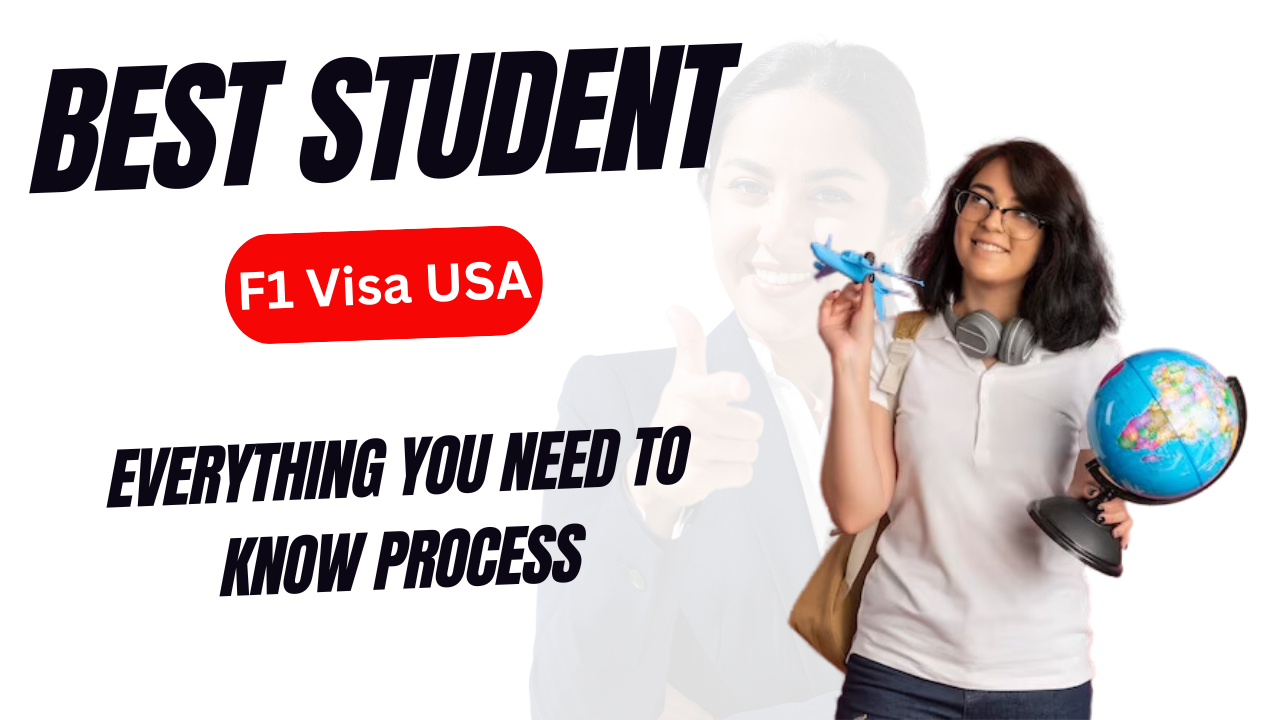Key to Your American Dream: Your Guide to the F-1 Student Visa
Did you know that over one million international students are currently pursuing their academic dreams in the United States? This number speaks volumes about the vibrant educational opportunities and diverse cultural experiences the US offers. But for international students, the journey begins with securing the F-1 student visa, your gateway to unlocking those dreams.
This comprehensive guide will equip you with all the knowledge you need to navigate the F-1 visa application process smoothly. We’ll delve into the eligibility requirements, application steps, and even offer valuable tips to help you ace your interview and secure your visa. So, buckle up and get ready to embark on your exciting academic adventure in the US!
Fulfilling the Prerequisites: Eligibility Requirements for the F-1 Visa
Before embarking on your visa application journey, it’s crucial to understand the key eligibility requirements:
1. SEVP-Approved School: The Student and Exchange Visitor Program (SEVP) is a government agency that oversees international students in the US. Your chosen institution must be SEVP-approved to ensure it meets the necessary standards and can legally host international students. Choosing an unapproved institution could jeopardize your visa application and academic aspirations.
2. Full-Time Enrollment: As an F-1 visa holder, you are required to be a full-time student, typically defined as taking a minimum course load as determined by your school. Exceptions for reduced course loads may be granted in specific situations, such as medical reasons or during your final semester. However, these require approval from your Designated School Official (DSO) at the university.
3. English Proficiency: Demonstrating sufficient English proficiency is crucial for academic success and is a mandatory requirement. You can showcase your language skills through standardized tests like TOEFL or IELTS, or by achieving the required score on your institution’s own English language placement test. Some universities may offer conditional admission with English language programs, allowing you to improve your proficiency while enrolled.
4. Financial Support: To secure your F-1 visa, you must convince the authorities that you have sufficient financial resources to cover your entire academic stay. This includes tuition fees, living expenses, and travel costs. You can demonstrate financial support through various documents like bank statements, scholarships, or sponsor letters.
5. Strong Ties to Home Country: To avoid concerns about immigration intentions, demonstrating strong ties to your home country is vital. This signifies your intent to return after completing your studies. Examples of strong ties include:
* Job prospects: Showing evidence of potential employment opportunities back home.
* Property ownership: Owning property in your home country can indicate a strong connection.
* Family ties: Close family relationships in your home country can demonstrate strong ties.
By understanding and meeting these eligibility requirements, you’ll be well on your way to securing your F-1 visa and embarking on your enriching academic journey in the US!
F-1 Visa Application Process: Step-by-Step Guide
Now that you’ve explored the eligibility requirements, let’s dive into the actual application process:
1. Gather Required Documents:
Before starting, ensure you have all the necessary documents:
- Valid Passport: Your passport must be valid for at least six months beyond your intended program completion date.
- I-20 Form: This form, provided by your SEVP-approved school, verifies your enrollment and serves as your visa application foundation.
- Financial Proof: Documents like bank statements, scholarships, or sponsor letters demonstrating sufficient funds for your academic stay.
- Proof of English Proficiency: Test scores like TOEFL or IELTS, or a letter from your university confirming your proficiency.
- Additional Documents: Depending on your specific situation, you may need additional documents like transcripts, diplomas, or travel itineraries.
2. Complete the DS-160 Application:
The DS-160 is the online non-immigrant visa application form. Complete it carefully and accurately, providing details like your personal information, travel history, and educational background. Pay close attention to the following sections:
- Travel Plans: Indicate your intended arrival and departure dates, aligning with your program duration.
- Educational Background: Accurately list your academic history, including institutions attended and degrees earned.
- Financial Support: Clearly outline your financial resources to substantiate your ability to cover expenses.
3. Pay the SEVIS Fee:
The SEVIS fee is a mandatory payment to support the Student and Exchange Visitor Information System (SEVIS). You can pay online using the designated portal and retain the payment confirmation for your records.
4. Schedule Your Interview:
Once your application and SEVIS fee are complete, schedule your interview at the nearest US embassy or consulate. Waiting times can vary, so plan ahead and book your appointment as early as possible.
5. Prepare for the Interview:
The interview is your opportunity to showcase your genuine intentions and qualifications. Here are some tips to prepare:
- Practice common questions: Anticipate and practice answering questions about your study plans, financial resources, and future goals.
- Dress professionally: Make a positive first impression by dressing professionally for the interview.
- Be confident and articulate: Speak clearly and confidently, demonstrating your enthusiasm and preparedness.
- Bring necessary documents: Carry your passport, I-20 form, DS-160 confirmation, SEVIS fee receipt, and any other relevant documents.
By following these steps and remaining well-prepared, you’ll be well-equipped to navigate the F-1 visa application process and pave the way for your educational journey in the US.
Additional Considerations for F-1 Visa Holders:
Exploring Work Opportunities:
While your primary focus should be on your studies, F-1 visas offer limited work authorization options:
- On-Campus Employment Authorization (work permit): This allows you to work part-time (up to 20 hours per week) on campus during your academic term and full-time during breaks.
- Optional Practical Training (OPT): After completing your studies, you can apply for OPT to gain practical work experience in your field of study for up to 12 months (or 24 months for STEM graduates).
Remember, consulting your Designated School Official (DSO) is crucial for guidance on work authorization options and any necessary procedures.
Bringing Dependents:
If you wish for your spouse and children to accompany you to the US, they’ll need to apply for dependent visas (F-2 and M-2 respectively). These visas allow them to reside in the US while you pursue your studies. However, specific requirements and processes apply, so consult immigration resources for detailed information.
Understanding Travel Regulations:
As an F-1 visa holder, ensure you understand travel restrictions and re-entry procedures:
- Travel restrictions: While holding an F-1 visa, you generally cannot travel to certain countries with specific travel warnings.
- Re-entry procedures: Whenever you travel outside the US, you’ll need to maintain a valid F-1 visa and ensure proper documentation for re-entry, like your I-20 form and proof of enrollment.
Staying informed about these regulations is crucial to avoid any complications during your stay in the US.
By understanding these additional considerations, you can gain a comprehensive overview of your rights and responsibilities as an F-1 visa holder, ensuring a smooth and successful academic journey in the United States.
Conclusion: Your American Dream Starts Here
The journey to studying in the US as an F-1 visa holder can be exciting but requires careful preparation. Remember, meeting the eligibility requirements and following the application process thoroughly are crucial.
This guide has equipped you with a comprehensive understanding of:
- Eligibility requirements: Ensuring you meet the necessary criteria, including SEVP-approved school, full-time enrollment, English proficiency, financial support, and strong ties to your home country.
- Application process: Gathering required documents, completing the DS-160 application, paying the SEVIS fee, scheduling the interview, and preparing effectively.
- Additional considerations: Exploring work authorization options, understanding the process for dependents, and being aware of travel regulations.
While this guide provides a solid foundation, remember that further research may be necessary based on your specific situation. Consulting with immigration professionals like lawyers or advisors can offer personalized guidance and address any complex questions you may have.
With dedication, preparation, and access to the right resources, you can successfully navigate the F-1 visa process and turn your American dream into a reality. Best of luck on your academic journey!
FAQs on F-1 Student Visa: Everything You Need to Know
1. What is the difference between an F-1 and M-1 visa?
An F-1 visa is for academic studies, while an M-1 visa is for vocational or non-academic programs, like certain trade schools or cosmetology programs.
2. Can I change my major after I receive my F-1 visa?
Yes, you can usually change your major, but you must notify your Designated School Official (DSO) at the university and they will update your SEVIS record to reflect the change.
3. Can I work while studying on an F-1 visa?
Yes, but with limitations. You can work on campus for up to 20 hours per week during the academic term and full-time during breaks. You may also be eligible for Optional Practical Training (OPT) after graduation, allowing you to work in your field of study for up to 12 months (or 24 months for STEM graduates).
4. How long can I stay in the US on an F-1 visa?
Your F-1 visa is typically valid for the duration of your academic program, as indicated on your I-20 form. You can apply for extensions if needed, but consult with your DSO for specific guidance.
5. What happens if my F-1 visa application is denied?
If your application is denied, you will receive a written explanation outlining the reasons for denial. You can reapply, but you must address the reasons for the previous denial in your new application. Consulting an immigration attorney can be helpful in this situation.
6. Can my spouse and children come to the US with me on an F-1 visa?
Yes, your spouse and children can apply for dependent F-2 and M-2 visas, respectively. However, they are generally not allowed to work in the US on these visas.
7. What documents do I need to bring to my F-1 visa interview?
You will need your passport, I-20 form, DS-160 confirmation, SEVIS fee receipt, proof of financial support, and any additional documents requested by the embassy or consulate.
8. What are some tips for a successful F-1 visa interview?
- Dress professionally and arrive early.
- Be prepared to answer questions about your study plans, financial resources, and future goals.
- Speak clearly and confidently, and be honest and truthful in your responses.
- Bring all required documents and be organized.
Remember, this is not an exhaustive list of FAQs. It’s crucial to consult official government websites and immigration resources for the most up-to-date and accurate information.




